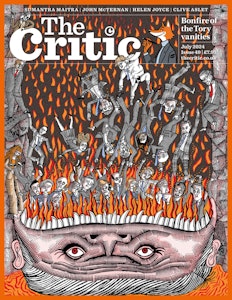This article is taken from the June 2024 issue of The Critic. To get the full magazine why not subscribe? Right now we’re offering five issues for just £10.
The label “difficult” gets overused for women, but in Courtney Love’s case, you can say she earned it. At 59, she’s lived every cliché of sex, drugs and rock ’n’ roll, and racked up a list of beefs that makes your average rapper look like a Quaker. In her own words: “I always wanted to be known as a bitch.”
That makes her perhaps a surprising choice to front a flagship radio series celebrating female musicians (Courtney Love’s Women, on BBC Sounds). But don’t worry: she quickly brought things back on brand with a Standard interview in which she shellacked probably the four biggest female musicians in the world.
Taylor Swift? “A safe space for girls” but “not interesting as an artist”. Beyoncé? “I just don’t like her music.” Madonna? “I don’t like her and she doesn’t like me.” And Lana Del Rey (who, a few years ago, was letting Love stay in her beach house, according to Love)? “I haven’t liked Lana since she covered a John Denver song, and I think she should really take seven years off.”
Such quotable stuff didn’t just pit Love against her peers. It also irked some of the most aggressive fandoms on social media, so ensuring another full cycle of news coverage for her show. Love gives the impression of being a rackety old survivor, but her chaotic methods get results.
Her image has wobbled between “cynical attention-seeker” and “punk provocateur” since the early 1990s, when she gained fame as lead singer of Hole. Shortly after that, she became extremely famous as the wife of Nirvana’s Kurt Cobain, who turned the nihilistic sound of grunge into a chart behemoth (they wed in 1992).
Then in 1994, Cobain shot himself, and Love was forced into a terrible level of fame as his widow. It’s traumatic enough to lose your husband in such a violent way, especially when you have a young child (their daughter Frances Bean Cobain is now 31). It’s even more so when you have to do it in the full glare of celebrity.
Nine months after Cobain’s death, Love told Rolling Stone: “from now on, people will refer to rock couplehood not just in terms of Sid and Nancy and John and Yoko but Kurt and Courtney. We’re in the pantheon.” But whilst Yoko Ono was unfairly blamed for breaking up The Beatles, at least no one insinuated that she had murdered her husband.
There were wild conspiracy theories about Love orchestrating Cobain’s death — though his working title for the last Nirvana album had been the explicitly suicidal “I Hate Myself and I Want to Die” (it was released as In Utero). Some people seemed to resent her simply for refusing to spend her life wearing widow’s weeds and tending the flame of his reputation.
Instead, she was honest about the problems of living with a depressed and self-destructive drug addict (both were using heroin, although Love has always denied the allegations in a 1992 Vanity Fair profile that she injected whilst pregnant). She dated, very publicly, generating a string of exes that range from the quite unlikely (Edward Norton) to the deeply improbable (Steve Coogan).
And she pursued her own work — first with Hole’s scathing 1994 album Live Through This (recorded before, but released after, Cobain’s death) and then the dreamy FM rock of 1998’s Celebrity Skin (my favourite). Stopping would have been unthinkable for someone who demonstrated ferocious drive from the very start.

Her early childhood in sixties San Francisco exposed her to the worst of the hippy dream (her father allegedly gave her LSD as a toddler). In 1976, she auditioned for the Mickey Mouse Club: by her own account, she read Sylvia Plath’s poem “Daddy” and was not asked back.
As a young adult, Love worked as a stripper to support herself and drifted through various bands. At 19, she moved to Liverpool and attached herself to the music scene. Julian Cope, of The Teardrop Explodes, was close to her, but after she and Cobain were anointed the first couple of grunge, Cope placed an ad in the NME reading: “Free us from Nancy Spungen-fixated heroin A-holes who cling to our greatest groups and suck out their brains.”
There was obviously misogyny at work, but Love generated hostility from all comers. People hated Love; Love hated back. When Hole were lumped together with the feminist punk Riot grrrl scene, Love mocked the bands on the song “Olympia”. In 1995, she allegedly struck Bikini Kill’s Kathleen Hanna backstage at Lollapalooza, although recollections vary.
She’s mellowed a little — in 2019, she moved to London, and she has taken up gardening and afternoon tea. But even at nearly 60, Love doesn’t feel like the finished article. She’s both vulnerable and confrontational: a feminist avatar who doesn’t want to be anyone’s sister; a rock ’n’ roll casualty who is also a survivor.
Love was never interested in “safe spaces for girls” (and the reaction to Swift’s latest album suggests diminishing returns on that project). Instead, Love has always been drawn to danger and excess: she’s a lot, and that’s as much of a good thing in 2024 as it was in the nineties.
Enjoying The Critic online? It's even better in print
Try five issues of Britain’s newest magazine for £10
Subscribe



